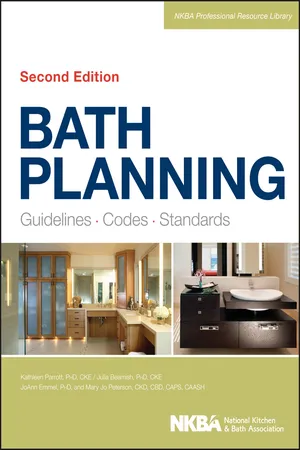
- English
- ePUB (mobile friendly)
- Available on iOS & Android
About This Book
The leading resource for student and professional bath designers—completely revised and updated
Bath Planning is the most authoritative resource available on the subject, containing everything a professional needs to know to design a safe, functional, effective, and attractive bath. Based on the National Kitchen and Bath Association's Kitchen and Bathroom Planning Guidelines and the related Access Standards, this book presents the best practices developed by the Association's committee of professionals through extensive research.
This Second Edition has been completely revised and redesigned throughout, with new full-color photographs and illustrations and a special emphasis on client needs, research, and references to industry information. Features include:
- New and expanded information on universal design and sustainable design
- The 2012 edition of the NKBA Planning Guidelines with Access Standards and up-to-date applications of the 2012 International Residential Code
- New information about storage, cabinet construction, and specifying cabinets
- Metric measurement equivalents included throughout
- A companion website with forms and teaching resources for instructors
Frequently asked questions
Information
1
Bathroom History, Research, and Trends
- Learning Objective 1: Describe how evolving lifestyles and technologies have impacted bathroom trends over time.
- Learning Objective 2: Describe new trends in present-day bathroom design.
A BRIEF HISTORY OF THE BATHROOM
Early Civilizations and the Bath

Latrines
The Middle Ages
Table of contents
- Cover
- Table of Contents
- Title
- Copyright
- Sponsors
- Gold Sponsors
- About The National Kitchen & Bath Association
- Preface
- Acknowledgments
- Chapter 1: Bathroom History, Research, and Trends
- Chapter 2: Infrastructure Considerations
- Chapter 3: Environmental and Sustainability Considerations
- Chapter 4: Human Factors and Universal Design Foundation
- Chapter 5: Assessing Needs
- Chapter 6: Bathroom Planning
- Chapter 7: Mechanical Planning
- Chapter 8: Accessibility in Practice
- Chapter 9: More Than a Bathroom
- Chapter 10: Putting It All Together
- Appendix A: Bathroom Planning Guidelines with Access Standards
- Appendix B: Measurement Conversions
- Glossary
- Resources
- Index
- End User License Agreement